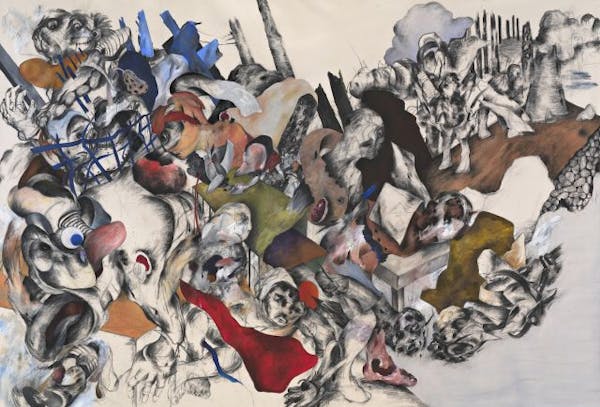Filling a 50-year gap in an art museum's collection is more than a checkbook issue, as the Minneapolis Institute of Arts recently discovered when it decided to expand its post-1960s holdings. The museum has been buying contemporary art fitfully for decades, but it had no firm direction for its purchases until it opened a $50 million wing in 2006 and hired its first contemporary art curator two years ago.
Much of the new space is intended for modern and contemporary art, a field that's crowded with competing styles and abuzz with high-octane collectors. Navigating all that is the job of Elizabeth Armstrong, now the museum's assistant director for exhibitions, programs and contemporary art.
"It's hard to find art of the highest caliber," said Armstrong, who was just back from a 10-day tour of artists' studios and galleries in South Africa. "For example, we'd like to have a Lucian Freud painting from the 1960s, but we can't find one."
What Armstrong has found is more than 80 paintings, sculptures, photos, installations and video works from the past 50 years that could be added to the museum's collection if the cards fell right. Borrowed from artists, collectors and galleries nationwide, the art is on view through Aug. 1 in "Until Now: Collecting the New (1960-2010)."
Besides pieces by such iconic names as Andy Warhol, Jasper Johns and Gerhard Richter, the loans include key works by respected figures such as Sylvia Plimack Mangold, Neil Jenney, Eric Fischl and Alfred Leslie, whose prices are less sizzling. Armstrong also sought important international talents sometimes neglected in the United States, including Venezuelan op-and-kinetic artist Jesús Rafael Soto, Japanese popster Yayoi Kusama, Russian expatriate Ilya Kabakov, Iraqi painter Ahmed Alsoudani and Canadian First Nations photographer Rebecca Belmore.
The show is intended in part as a kind of shopping guide for institute benefactors, especially board members who might buy pieces on loan from galleries and donate them to the museum. To that end, it includes significant work by undervalued and therefore more affordable talents. The market in contemporary art is "convoluted," Armstrong said. Prices don't necessarily reflect the inherent quality of the art, but sometimes just measure trends, rumors and the caprice of collectors and dealers.
"I'm not one who believes the price of contemporary art is equivalent to its aesthetic value," said Armstrong. "The market goes up and down with changing taste."
She also hopes for gifts from collectors who own the sort of marquee names that make headlines at auction. "For icons of the '60s and '70s, you have to go to collectors because no museum can afford those pieces," Armstrong said, noting that "a small, good Roy Lichtenstein" pop-art painting would cost "exponentially more" than all the work by less famous artists that she's borrowed.
"I wanted to show private collectors what power they have to transform this museum" with gifts of art, she said.
One potential donor, Florida collector Gordon Locksley, who with his former business partner George T. Shea lent 20 pieces to the show, basked in the museum's attention at opening-weekend parties and dinners. He made no public promises about the future of his collection, but at a Saturday afternoon talk urged the standing-room-only crowd to "support the museum any way you can; if Aunt Frieda dies and leaves you something valuable, donate it, and pony up when the museum needs money."
Applied expertise
Before joining the institute's staff, Armstrong held curatorial posts for 25 years in contemporary museums in Newport Beach, Calif., and San Diego and at Walker Art Center in Minneapolis, where she worked from 1982 to 1996. At such institutions the standard tactic is to spot talent young and to buy before the prices rise. That approach is too risky for a traditional museum like the institute, however, where new pieces need to resonate with an established canon of work spanning more than 2,000 years and every continent.
"I had to put on my revisionist hat and order some books, and make lists of who's out there and who's been forgotten but is still important," Armstrong said. Her knowledge of the Walker's collection was especially helpful in avoiding the kind of duplication that in the 1960s and '70s resulted in both museums owning major paintings by Chuck Close, Frank Stella and other modernists. After decades of none-too-subtle rivalry, the museums are now cooperating and even lending each other art.
"As we continue to collect contemporary art, we will differ from the Walker because we will deal more with hindsight," said Armstrong. "We will wait to see who has a significant body of art, though at the same time we will sometimes buy art from last year."
The museum's trustees are so enthusiastic about the new direction that they have purchased several significant contemporary works, including a monumental etching by South African artist William Kentridge, a sculpture by Lebanese-born Palestinian Mona Hatoum, and the museum's first-ever video installation, Doug Aitken's "Migration (empire)," a mournfully poetic meditation on the end of the American wilderness.
Before she presented the video to the museum's board for purchase approval, Armstrong worried that the trustees would reject it as too radical. To her surprise, one of the board members was in tears when it ended. A collector of 19th-century American art, the trustee understood intuitively how the video -- which includes wild animals trapped in soulless hotel rooms -- related to her paintings of the American West.
Aitken's video is a perfect example of the kind of contemporary art the museum seeks, said institute director Kaywin Feldman. "For us, contemporary art is about the experience of how it fits into the collections we already have here. It's a new initiative, but it will become more a part of what we're doing."
Mary Abbe • 612-673-4431

This retired journalist changed professional wrestling from Mankato

All-Metro Sports Awards: Here are the 2023 winners

